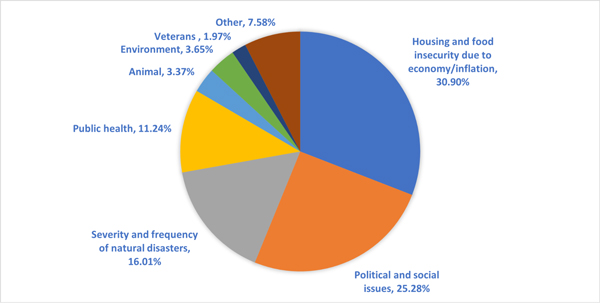
How do Charity Navigator Users Plan to Give in 2023?
Helpful donating insights from 356 individuals.
In the first quarter of 2023, Charity Navigator invited users to respond to a survey about their planned giving for the year. 356 individuals responded, providing insights into how donors are being influenced by economic, political, and environmental factors. The sample is relatively small, and skewed by the fact that all respondents are donors actively engaged with Charity Navigator. Nonetheless, there are trends revealed in the data that can be useful to donors, nonprofits, and other stakeholders interested in giving in the year ahead.
What Issue Areas Are Donors Concerned About?
Donor concerns are well spread between a number of causes, with a few clear trends standing out from the rest. Although inflation has receded from its highest point, the economy remains the primary concern for 30.9% of surveyed donors, who are worried about the affordability of essentials like food and housing. These concerts are well-founded, as food and housing costs are both on the rise, to the detriment of many. In our age of public mistrust in key institutions including the American government and media, we cannot be surprised that 25.28% of respondents cited political and social issues as their primary concern. Equally unsurprising is the group primarily concerned with natural disasters (16.01%). Natural disasters have been increasing in frequency and severity for years. 2023 has already hosted a number of disasters, with more sure to come.

How Much Are Donors Planning to Give in 2023?
Please note that in this section, the skew created by the fact that survey respondents are Charity Navigator users is likely to be particularly relevant to the answers given.
Encouragingly, more than half (51.7%) of respondents indicated that intend to maintain approximately the same level in 2023 compared to 2022. Another 42.3% stated that they planned to increase their giving. Among those who plan to increase their giving, 83.2% cited increased need as the reason for their choice. Financial shifts played a role as well, with 25.2% of the group indicating that increased income was driving their choice and 10.7% citing successful investments as the motivation.
Just 6% of respondents said that they plan to decrease their giving. Those who plan to decrease their giving cited financial concerns including less income or hardship (58.2%), inflation (27.3%), and unsuccessful investments (12.7%).
Some of those who plan to give more and those who plan to give less shared the same motivation for their differing choices. 13.7% of those who plan to give more are motivated by tax incentives, while 16.4% of those who plan to decrease their giving cited a lack of tax incentives. This dichotomy may suggest conflicting perceptions of the value of existing tax incentives, or perhaps gaps between in value of tax incentives for different tax brackets. 14.5% of those who plan to give less and 6.9% of those who plan to give more in 2023 are donation bundlers. Donation bundling is a tax strategy that involves grouping one's charitable contributions for two years into one year. This means that over time the donations made by these individuals should even out, and will not result in less overall charitable giving.
How Do Donors Plan to Give in 2023?
Giving in a way that makes sense for both you and the charity you want to support is key to a good giving plan. In 2023, 60% of surveyed donors plan to donate online. 37.8% intend to mail checks to charities. A smaller number of respondents plan to give through means other than cash: donor-advised funds (9.2%), stock transfers (4.4%), and cryptocurrency (2.2%).
24.8% of surveyed donors plan to give on a recurring basis in 2023. This is an encouraging statistic, as recurring gifts are one of the best ways to support a charity. With benefits for both the donor and the nonprofit, we recommend recurring gifts in most cases. If you are interested in setting up a recurring donation, many charities directly facilitate the process. You can also set up recurring donations to one or more charities through the Giving Basket to manage your giving in one secure place.
On June 9, many market analysts celebrated that the stock market increased 20% from its low, often referred to as a bear market. The US entered bear market territory in June 2022 and hit its lowest point around October 2022. While this is good news for investors, it may be good news for charities, especially when combined with results from our donor survey.
Based on a study conducted in 2010 by two economists from the University of Chicago, it was found that the direction of the stock market influences the relationship between charitable giving and stock performance. The study, titled "Charitable contributions exhibit differential response to stock market fluctuations," examined data spanning from 1967 to 2008. The researchers discovered that while charitable donations tend to decrease following a period of poor stock market performance, the correlation is more significant during periods of stock market growth. Several factors were proposed to explain this phenomenon. Firstly, it is suggested that charitable donations become more valued during economic downturns. Additionally, social pressure may play a role in encouraging donors to maintain or surpass their previous year's giving. Lastly, individuals may be more inclined to contribute a portion of their windfall earnings from positive stock performance, which naturally strengthens the correlation between charitable giving and upward stock trends.





